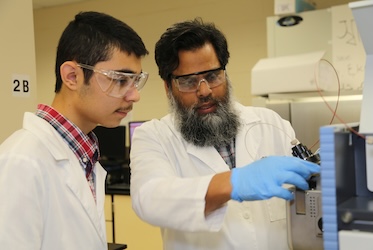

KENNESAW, Ga. | Jul 27, 2017
Biology associate professor Marcus Davis has the answers

Is a #Sharknado possible? Read below for all the answers to your most burning shark-related questions, tackled by Kennesaw State University’s Associate Dean for Research Marcus Davis, associate professor of biology. #SharkWeek
Is it true that sharks don’t have bones?
Ah yes, the classic question! Sharks have skeletons with individual components just like other vertebrates – including humans – which we refer to as bones. For example, as in humans, sharks have a head with teeth and jaws; they also have a spinal column, including vertebrae. However, sharks differ in that their skeletons remain composed of cartilage throughout their lives, and do not transition as they grow into the mineralized hard tissue we call bone. So, somewhat confusingly, not all bones are made of bone, some are made of cartilage! Interestingly, scientists have recently discovered that sharks are missing a single gene family that regulates the process of cartilage transition into bone, and that a gene duplication within this family may have been the key to the origin of the unique bone forming potential we humans inherited from a first bony ancestor.
Are people related to sharks?
Yes, we are, but the question is “to what degree”? New fossil discoveries are helping us understand when in evolutionary history did sharks and their relatives branch from the vertebrate tree of life, and new genetic comparisons of sharks and other animals are helping uncover just how similar we really are to our toothy aquatic cousins.
Do sharks sleep while swimming? I’ve heard they have to always remain in motion?
Sharks extract the oxygen they need through their gills, the equivalent function of a human breathing through their lungs. This is all about respiration! Humans use muscular contractions to move air across the surface of the lung so that specialized cells can extract the oxygen we need for metabolic processes. Fish, including sharks, accomplish this task by moving oxygenated water across the surface of their gills, either by muscular contractions of their mouth and gills or by ensuring that water is flowing across them. One way to move water across the gills is to keep moving, but another is to settle down for a nice “shark nap” in a strong undersea current … where the watery “breeze” keeps fresh oxygenated water moving your way!
What can we learn by studying sharks?
We learn about ourselves by making comparisons and contrasts with other animals in the world. How are other vertebrates built? How is their anatomy different than our own? Do they use the same genetic circuits to build their body parts as a human does? Are they susceptible to the same diseases as us? Why or why not? In studying shark anatomy, development, genetics, or behavior we gain insights into another successful natural experiment in “how to build a vertebrate”. This comparative method is actually the cornerstone of modern research medicine, and why we use animals like mice and fruit flies to understand human disease. To me and my fellow researcher, everything sharks illuminate for us shines back brightly on the human condition.
When did sharks originate?
To understand the origins of animal groups, we turn to the “checks and balances” data provided by the fossil record and DNA comparisons. The earliest fossil evidence for sharks is around 420 million years old from the Silurian period in Earth’s history. Estimations of DNA changes over time from a variety of living sharks and land animals further support this origination time. So, if you want to see the very first shark ancestors (they would have looked a bit different than a Great White shark), set your time machine to the Silurian!
Do sharks get cancer?
Sharks do get cancer, just like humans. Researchers have documented cases of cancer in nearly two dozen different shark species. Sadly, this myth has been perpetuated by those promoting shark cartilage as a human cancer cure. However, there is no clinical evidence showing that consuming shark cartilage helps fight cancer. Worse still, this myth has led to the overfishing of many shark species, contributing to their population decline and the risk of extinction for many. If sharks can help us cure cancer, it will be through their careful study, not by eating them!
What are some of the funnier names of sharks? Dogfish, catshark, etc.
There’s a carpet shark called the Tassled Wobbegong. Hands down winner. Next question!
Why do sharks attack people?
We are not the natural prey item of any shark species. We’re land animals, and throughout most of the shark’s history humans didn’t even exist. Compare 400 million years of natural selection against a few million years for humans and our closest ancestors! As far as sharks are concerned, we showed up on Earth last Thursday. It’s important to realize that sharks rarely attack humans, and when they do, it’s usually a case of mistaken identity. We go out on surfboards and in wetsuits, flopping around like a tasty seal or sea turtle … what’s a hungry shark supposed to think? “Sorry human, I thought you were the lunch special!”
Is a Sharknado possible?
I will venture that this actually does happen on occasion. There was a cyclone down in Australia a few years ago, and local officials in Queensland reported finding a deceased 5-foot bull shark on land and far from shore after the storm had passed. Before anyone panics, this incident demonstrates the important point, which is that any shark unlucky enough to be picked up by a waterspout or cyclone is not going to have a good day. Fear for the shark’s safety … not yours!
What's the biggest shark? How big?
The biggest shark that ever lived (as far as we know) was a now-extinct species of Carcharodon often referred to popularly as Megalodon. Megalodon lived between 23 million and about 3 million years ago, going extinct around the end of the Pliocene Epoch. It would have looked like an extra-large, stocky version of a great white shark and is estimated to have grown in excess of 50 feet in length! That’s bigger than a school bus! Living great white sharks max out around 20 feet in length – still impressive. However, great whites don’t hold the title for the largest living shark. As every kid will probably remind you, that title is held by the whale shark, a docile filter-feeding giant that can grow to 40 feet in length!
— Robert S. Godlewski
Photo: David Caselli

KSU graduate overcomes adversity to earn biology degree

Rising above challenges marks inspiring career of President's Award of Distinction recipient

Assistant professor receives NIH grant to improve preservation and storage of peptide and protein-based drugs

Chemistry alumni use research as springboard to industry careers
A leader in innovative teaching and learning, Kennesaw State University offers undergraduate, graduate, and doctoral degrees to its more than 51,000 students. Kennesaw State is a member of the University System of Georgia with 11 academic colleges. The university's vibrant campus culture, diverse population, strong global ties, and entrepreneurial spirit draw students from throughout the country and the world. Kennesaw State is a Carnegie-designated doctoral research institution (R2), placing it among an elite group of only 8 percent of U.S. colleges and universities with an R1 or R2 status. For more information, visit kennesaw.edu.